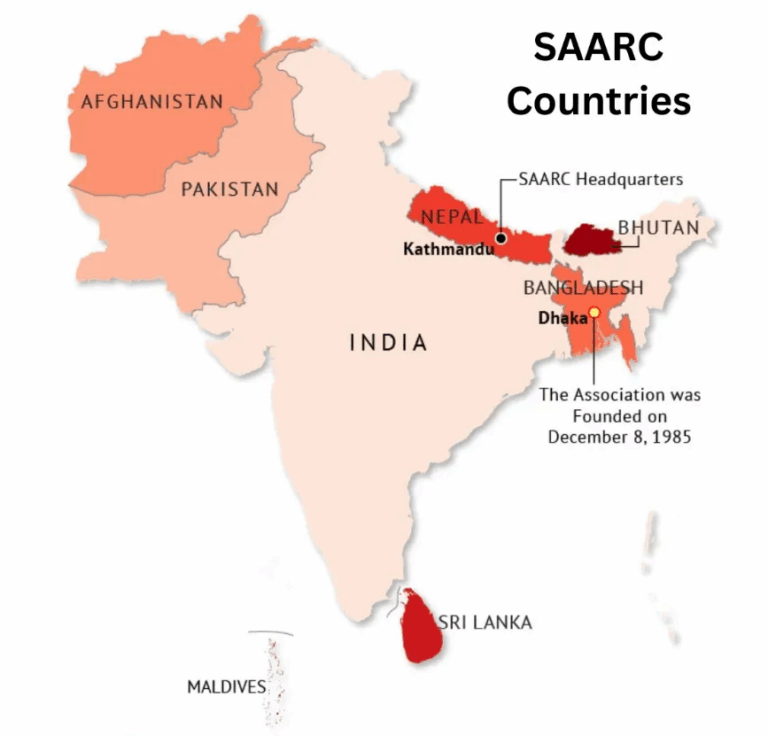WMO’s 2024 Climate Report for Asia: Key Highlights & Warnings
Why in the News?
The WMO (World Meteorological Organisation) has released its annual “State of the Climate in Asia 2024” report, warning of record-breaking temperatures, glacial retreat, intensified cyclones, and devastating floods across Asia, highlighting the continent’s acute vulnerability to climate change.
Background
About WMO:
- A specialised UN agency founded in 1950, succeeding the International Meteorological Organisation (1873).
- Headquarters: Geneva, Switzerland
- Focuses on weather, climate, and water-related issues, supports disaster risk reduction, climate monitoring, and early warning systems.
- India is a member among WMO’s 193 members (187 countries + 6 territories).
- Purpose of the Report:
The “State of the Climate” report is an annual flagship publication by the WMO, synthesising meteorological, hydrological, and disaster data to guide climate policy and regional preparedness. - Asia’s Climate Vulnerability:
- Asia is home to 60% of the global population.
- Includes low-lying coastal nations, Himalayan ecosystems, and megacities, all highly sensitive to climate variability.
- The region is exposed to tropical cyclones, glacial floods, heat waves, droughts, and rising sea levels.

Features / Key Findings of the 2024 Report
Record-Breaking Temperatures
- 2024 was the warmest year in Asia since records began.
- The global mean temperature exceeded the previous 2023 record of 1.45°C, making it the hottest year since 1850.
- Heatwaves were widespread and intense:
- Myanmar recorded 48.2°C, the highest in its history.
- Countries like India, Japan, South Korea, and Thailand reported prolonged extreme heat events.
Glacier and Snow Loss
- 23 out of 24 monitored glaciers in the Himalaya and the Tian Shan experienced mass loss.
- Consequences:
- Rising risks of Glacial Lake Outburst Floods (GLOFs).
- Reduced river flow in the long run, affecting agriculture and water supply.
Cyclones and Storm Surges
- Cyclone Remal:
- Made landfall in Bangladesh and eastern India with winds at 111 km/h and storm surges of 2.5 metres.
- Cyclones Asna and Fengal affected Oman, India, and Sri Lanka.
- Storms are becoming more intense and wetter due to warmer oceans.
Marine Heatwaves
- Abnormally high sea surface temperatures affected the Indian Ocean, the Pacific Ocean around China, Japan, and India.
- Implications:
- Coral bleaching.
- Collapse of local fisheries.
- Accelerated monsoon variability.
- Floods and Landslides
- Flash floods in Kerala, Nepal, and Sri Lanka killed hundreds and displaced thousands.
- Urban flooding is worsened by unplanned construction, poor drainage, and extreme rain bursts.
Drought and Crop Damage
China experienced a severe drought:
Affected 4.8 million people.
Destroyed over 335,000 hectares of crops.
Economic loss: CNY 2.89 billion.
Challenges Highlighted
- Extreme Weather Becomes the Norm
Events like 48°C heat, glacial loss, or cyclones are no longer exceptions but recurrent and intensifying.
Data and Monitoring Gaps
- Many South Asian and Central Asian countries lack dense meteorological networks or real-time data systems.
- Climate resilience efforts are fragmented across South Asia, East Asia, and Central Asia.
- Transboundary river systems (like the Indus, Ganga, and Mekong) lack a joint climate-disaster response.
Loss of Biodiversity and Ecosystem Services
- Marine heatwaves and floods are damaging wetlands, coral reefs, and glacier-fed river ecosystems.
Climate-Induced Migration and Displacement
- Millions are at risk of becoming climate refugees due to sea-level rise, droughts, or flood disasters.
Way Forward
Strengthen Regional Early Warning Systems
- Implement WMO’s Early Warnings for All (EW4ALL) across Asia.
- Prioritise investment in hydromet services and disaster risk communication.
Improve Glacial and Monsoon Monitoring
- Expand high-altitude weather stations and satellite-based tracking of glaciers and snowpack.
- India and China must lead a Himalayan climate observatory network.
Mainstream Adaptation into Development Plans
- Climate-resilient urban planning, crop selection, water conservation, and infrastructure design.
- Build climate-smart agriculture to handle droughts and floods.
Enhance International and Subregional Cooperation
- Strengthen the SAARC Disaster Management Centre and BIMSTEC climate programs.
- Data sharing and joint modelling of cyclones, floods, and glacial melt.
Climate Financing and Technology Transfer
- Mobilise green climate funds and support from Multilateral Development Banks.
- Help Least Developed Countries (LDCs) access climate risk insurance, early warning tech, and resilient seeds.
Education and Community-Based Resilience
- Public awareness of heat action plans, flood safety protocols, and drought preparedness.
- Local governance and Panchayats must be trained to act on early warnings.
FAQ (Frequently Asked Questions)
1. What is the WMO, and what does it do?
The World Meteorological Organisation (WMO) is a specialised UN agency established in 1950. Headquartered in Geneva, it coordinates global efforts on weather, climate, water resources, and early warning systems. It has 193 members, including India.
2. Why is this report significant in 2024?
The 2024 report warns that Asia is facing its warmest year on record, with:
• Record heatwaves (e.g. 48.2°C in Myanmar),
• Intensified cyclones like Remal and Asna,
• Marine heatwaves affecting fisheries and monsoon patterns,
• Deadly floods and droughts impacting millions.
3. What is the purpose of the WMO’s “State of the Climate” report?
The annual report provides a scientific assessment of Asia’s climate trends using meteorological, hydrological, and disaster data to:
• Support regional climate preparedness,
• Guide climate policy,
• Inform early warning and adaptation systems.
Conclusion
The WMO’s State of the Climate in Asia – 2024 underscores the climate emergency confronting Asia. With rising temperatures, glacier retreat, and more frequent climate disasters, nations in the region must act urgently and collaboratively to build climate resilience, strengthen early warning systems, and mainstream adaptation into every development strategy. For India, the findings are a timely wake-up call to prioritise climate-smart infrastructure and policy as a national imperative.
MAINS PRACTICE QUESTION
Question: What are the key findings of the WMO’s State of the Climate in Asia 2024 report, and what do they imply for climate resilience in India?
PRELIMS PRACTICE QUESTION
Q. About the WMO’s State of the Climate in Asia 2024 report, consider the following statements:
- The year 2024 recorded the highest average temperature in Asia since 1850.
- All 24 monitored glaciers in the Himalaya and Tian Shan showed mass gain due to enhanced snowfall.
- Cyclone Remal made landfall with wind speeds exceeding 110 km/h and caused storm surges of up to 2.5 metres.
- Marine heatwaves had no significant impact on monsoon variability or fisheries in the Indian Ocean region.
Which of the statements given above is/are correct?







